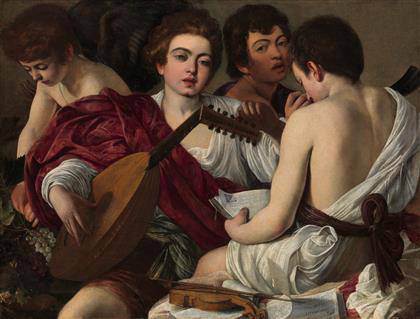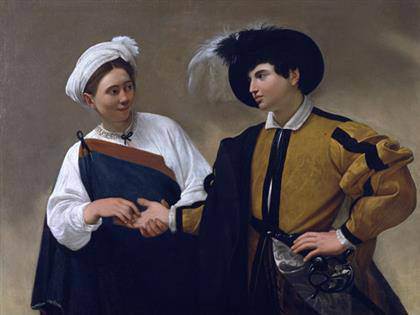
Caravaggio. The musicians (1596-1597). The Metropolitan Museum of Art, New York

Caravaggio. The Fortune Teller (1595-1596). Musei Capitolini, Roma
Caravaggio and the Painters of the North From 21 June to 18 September 2016, Museo Thyssen-Bornemisza presents ‘Caravaggio and the Painters of the North’ an exhibition that focuses on Caravaggio and his influence on the northern European artists who were fascinated by his painting and disseminated his style]]>
Source: Museo Thyssen-Bornemisza
On display will be 53 paintings, twelve of them by Caravaggio, loaned from private collections,museums and institutions such as the Metropolitan Museum of Art, New York, the Galleriadegli Uffizi, Florence, the Hermitage Museum, Saint Petersburg, the Rijksmuseum, Amsterdam,and the church of San Pietro in Montorio in Rome. The exhibition will offer a survey ofCaravaggio’s career from his Roman period to the moving dark paintings of his final years,shown alongside a selection of works by his most important followers in Holland (Dirk vanBaburen, Gerrit van Honthorst and Hendrick Ter Brugghen), Flanders (Nicolas Régnier andLouis Finson) and France (Simon Vouet, Claude Vignon and Valentin de Boulogne).
Between 1600 and 1630 more than two thousand artists settled in Rome, of whom a thirdwere foreigners who transformed the city into an artistic melting-pot. To an equal or evengreater extent than the Italians, the northern European painters opted to follow Caravaggio’sstyle for two principal reasons: the lesser importance of the classical element in the northernpictorial tradition, and the suitability of Caravaggio’s style for application outside thetraditional context of a studio or drawing academy.
In the Low Countries and Germanic regions working from life through the observation ofvisible elements taken from the surrounding context was a firmly-rooted tradition. Thisestablished a link with the manner of working characteristic of Caravaggio, whose Lombardorigins predisposed him to paint ad vivum, an approach that artists with a classical trainingconsidered inadequate in that it represented an obstacle to achieving perfection in art.
In addition, most of the Dutch, Flemish and French painters who settled in Rome had receiveda basic training in drawing and painting in their native regions and were particularly interestedin rapidly capturing and assimilating new ideas. Caravaggio’s art thus appealed to them, notonly for the possibility of working from life but also for its emphasis on the use of light, shadowand colour. The foreign painters were able to assimilate this style into their own without therestrictions implied by a study programme.
“Caravaggio and the Painters of the North” transports visitors to the era of Michelangelo Merisida Caravaggio and the decades following his death, a period particularly rich in masterpieces ofpainting and when his fame was still at its height. The exhibition opens with two galleriesdevoted to works by Caravaggio executed during his time in Rome and which reveal his multifacetedcareer. The following galleries show works by painters from north of the Alps who sawCaravaggio’s works at first hand. The result of their impressions was manifested in the widestvariety of ways, given that each brought their own contribution while also seeking out newmodes of expression in both religious and secular art. The last two galleries are devoted to thework of Caravaggio and his foreign followers in Naples and southern Italy.
Related content
Caravaggio and Connoisseurship – Museum of Fine Arts, Boston (exhibition, 2014)
Follow us on:


